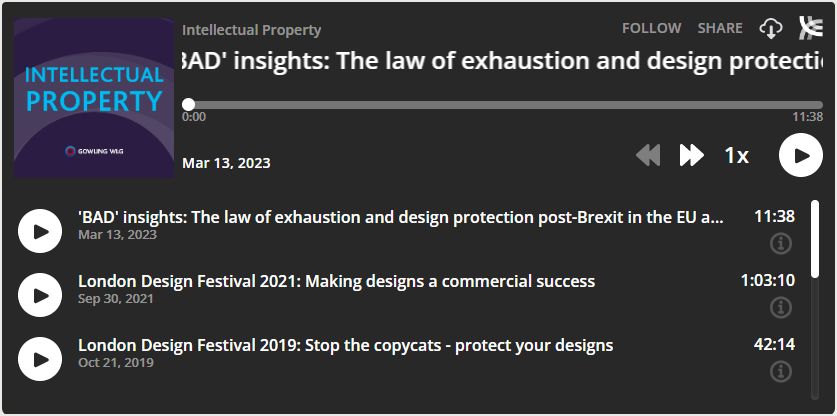In our new "BAD" (Brands, Advertising and Designs) podcast series, our Intellectual Property (IP) team will explore critical topics affecting the IP sector and how you can protect your brands, creations and designs.
What is the law of exhaustion and how does it affect you? Brand owners need to be aware of the law of exhaustion if they are involved in the movement of genuine goods protected by an IP right.
In this first episode of the series, IP team member Jasmine Lalli will take you on whistle-stop tour of national, regional and international exhaustion following Brexit and how this affects brand owners when it comes to the distribution and resale of their goods.
You will also hear about design protection in both the EU and UK, the different systems of unregistered design right protection, and the changes designers need to know about post-Brexit.
Listen to the episode
Listen to more episodes from our Intellectual Property podcast
Subscribe to 'Intellectual Property' on: Apple Podcasts | Spotify | Google Podcasts
Transcript
Automatic: Welcome to the latest episode of Gowling WLG's Global Intellectual Property podcast, where we discuss a range of topics to help you protect your brands, creations and inventions.
Jasmine Lalli: Hello listeners, my name is Jasmine Lalli and I am an associate in our IP team here to talk to you today about the law of exhaustion and design protection in a post-Brexit world.
This podcast is designed to give you a whistle-stop tour through these two areas, starting firstly with exhaustion. If your business is involved in, or interested in, the movement or resale of genuine goods protected by an IP right, then you need to know about exhaustion.
In general terms, once a good has been placed on the market in a specific territory, by or with the consent of the right holder, the IP rights that protect this good are considered to be exhausted. Now what does that mean? This means that the IP rights in question will fall away, the consequences being that the right to take legal action against infringement has been lost. As a result, there is a loss of the right to control distribution and/or the resale of these physical goods.
Let's take a basic example then just looking at the UK. Say I buy a pair of second-hand Nike trainers on eBay within the UK that were originally purchased first hand from a shop also within the UK. Applying then the law of exhaustion, the trademarks rights are exhausted from the moment that Nike places them on the UK market. Nike therefore cannot stop that seller from selling them to me or for putting them on eBay in the first place by using trademark infringement as their cause of action.
It's important to note that the law of exhaustion only applies to genuine goods, not infringing goods, such as counterfeit goods. Counterfeit goods will give rise to a separate cause of action for IP infringement.
Exhaustion also does not apply to digital content. It only applies to physical goods. Please also note that the rules around exhaustion will vary both by IP right and by territory, and you may come across different systems of exhaustion.
There is national exhaustion; whereby the brand owner's rights are exhausted for a specific country once goods have been placed on the market in that country by the brand owner. The exhaustion here will therefore not extend to other countries or other regions, so taking again that example I gave you with the Nike trainers, the brand owner's rights in that example were exhausted in the UK but not elsewhere, and they can't therefore rely on these IP rights to prevent the unauthorised sale of those goods in other markets, say for example in China.
There are then also regional and international systems of exhaustion, which is once goods have been put on the market somewhere in the world by a brand owner, the owner has exhausted its rights concerning the sale of those goods in other places across the globe.
So, turning now to Europe. The EU implements a system of regional exhaustion to help facilitate the free movement of goods within the single market. So, in essence, where you place goods in one member state, the IP rights are considered exhausted throughout the European Union. The exhaustion of intellectual property rights underpins this system that allows for parallel trade of certain goods.
So, just as a reminder for listeners who are unfamiliar, parallel trade happens when goods that have been sold in the single market or the European Economic Area (EEA) are then reimported by unconnected distributors back into the UK, usually to compete with domestic products. This happens particularly where the products are sold at a higher price on the domestic market but are cheaper elsewhere.
You can understand that the EU's rationale for permitting the exhaustion of rights across the single market, where they are placed on the market in one member state. This equal treatment of member states is to facilitate the free movement of goods throughout the EU. So, if I place goods on the market in France you can see why the IP rights would then still be exhausted in Germany. You would not want a trader in France pursuing a reseller in Germany, for example patent infringement for medical products.
Let's look now at the UK's position post-Brexit. The current position is that IP rights in goods legitimately placed on the market in the UK or anywhere else in the EU or the EEA are considered exhausted, so that the goods can lawfully be reimported back into the UK from the IP law perspective. For example, say I sell a product in Germany and then reimport it back into the UK, I now have no rights to enforce trademark infringement within the UK. However the position is not reciprocated. So, under the European rules, IP rights in goods placed on the market in the UK are not exhausted and the goods cannot freely be exported to the EU. So, we have this asymmetric approach.
This means that businesses exporting these IP protected goods from the UK to the EEA might need the right holder's consent. As you can appreciate, while this may benefit certain rights holders who wish to prevent the movement of their IP protected goods, for others it presents a real administrative burden. So, since Brexit and the UK's departure from the EU there has of course been the question of whether the UK's laws on exhaustion will change.
So the UK Government launched a consultation into the UK laws of exhaustion in the summer of 2021. The options considered were: firstly, a UK plus regime which was essentially a continuation of the current unilateral exhaustion regime; a national regime where the import of goods from any country would not automatically be permitted, however exports would be automatically permitted to countries with an international regime; a new international regime, which would automatically permit the import of goods from any country assuming there is separate authorisation for regulated goods, for example medicine, while exports would be automatically permitted only to other countries with an international regime; or a mixed regime, where the ability to parallel import goods would depend on the decision or treatment for the IP right, good or sector.
So, Switzerland currently operates such a regime, with national exhaustion applicable to medicine and then EEA wide or international exhaustion for most other goods. Countries such as Australia have also experimented with a mixed regime. Australia introduced a limited parallel import restriction but purely for books. So, the UK consultation concluded that there would be no changes and they would therefore continue with the existing UK regime. IP rights will therefore continue to be considered exhausted and therefore not enforceable in the UK in respect of genuine goods put in the market in the EU by the IP right owner or with their consent, which are then subsequently imported back into the UK.
Essentially, this position was identified as the continuation of the least costly for businesses relying on the EEA for the supply of goods and raw materials, whilst continuing to provide the same level of choice for UK consumers.
The future direction on the law of exhaustion in the UK will therefore be in large part a matter for the courts. So, if you are up for making new law, prepare your arguments and be ready for an outing to the Supreme Court.
Secondly, in this podcast we wish to briefly cover the issue of design protection in the post-Brexit landscape. So, the headline points relate to unregistered design rights.
As a refresher, both the EU and the UK offer systems of unregistered design right protection, known as unregistered community design right and UK unregistered design rights respectively.
The design protection begins from the date you make the designs in question available to the public, i.e. when they were first disclosed. The old rule was that disclosing your unregistered design in either the UK or the EU would entitle you to protection in both, as the UK was part of the EU. Now then, designs disclosed in the UK will no longer enjoy the benefit of unregistered community design protection within the EU post-Brexit.
So in order to attract unregistered community design protection for a new design, that design must firstly be disclosed within the EU, which no longer includes the UK. Conversely, in order to attract UK unregistered design protection, it will be necessary to firstly disclose the design within the UK. Disclosure in the EU - no longer sufficient.
It follows therefore that designers may have to decide whether to disclose first in the EU, to get unregistered community design protection, or in the UK, to get unregistered UK design protection, knowing they cannot have both. Obviously, there are pros and cons to each; the EU is obviously a much broader market than the single country of the UK, but unregistered design rights last for up to 15 years in the UK and just three years in the European Union. However, designers may take the practical approach of arranging for simultaneous disclosure of their designs in the UK and in the EU, in order to present the argument that the designs were first released in both. In most instances this could only be done online. It is not clear whether first disclosure, which takes place online, for example on a website or on social media, would satisfy the requirement of first being disclosed in the EU and the UK. There is a risk that an online disclosure will not satisfy the EU or UK requirements and hence fail to attract unregistered protection in either territory.
To ensure a degree of unregistered design protection, designers may consider disclosing their designs in one territory to get unregistered design protection there and then registering a registered design in the other. However, there is a significant degree of risk in this strategy as you may end up creating a piece of prior art, by disclosing in one territory thus destroying the novelty of your design in the other. In this climate, it is of course then preferable to seek registered design protection in both the UK and the EU to avoid reliance on unregistered designs altogether.
So, are there any plans in place from the UK IPO to investigate this situation further? In the summer of 2022 the UK IPO launched a call for views into the current UK design system and how best to improve it post-Brexit. The IP team here at Gowling WLG has been in touch with them late last year to query what the status was and they let us know that the next stage of the review has been delayed to late 2023 or early 2024 at the earliest. In other words, it has been punted into the long grass. So, it will be a case of watching this space.
What are the key takeaways then from this whistle-stop tour through the laws of exhaustion and design post-Brexit?
When it comes to exhaustion rights, the main things to keep in mind when trading goods are whether the goods being imported or exported have IP protection at all.
Secondly, the direction of those goods i.e. are they from the UK to the EU, or from the EU to the UK, or within either territory.
And finally, whether you need consent of those rights holders whose rights are not exhausted.
Moving on then to design protection, in the post-Brexit era we find ourselves in, it is important to remember that designs no longer qualify for both UK and EU unregistered design protection. For this reason before disclosing a design, it is important to consider whether designers would wish to attract unregistered community design protection or UK protection.
That brings this podcast to an end. Thank you very much for taking the time to listen and if you have any questions, please do reach out to the IP team here at Gowling WLG.
Automatic: Thanks for joining Gowling WLG for this podcast. If you enjoyed this episode be sure to check out our website at gowlingwlg.com for more useful insights and resources and don't forget to subscribe to ensure you join us for our next episode.
"Read the original article on GowlingWLG.com".
The content of this article is intended to provide a general guide to the subject matter. Specialist advice should be sought about your specific circumstances.



